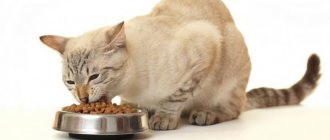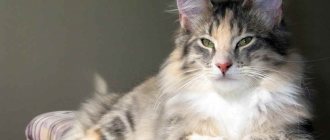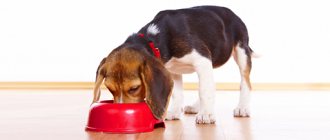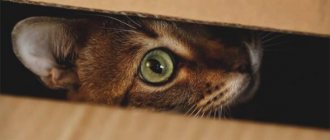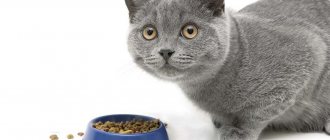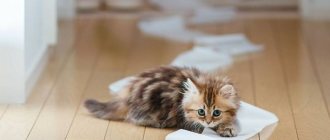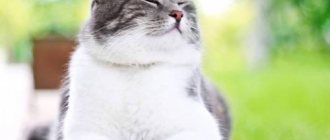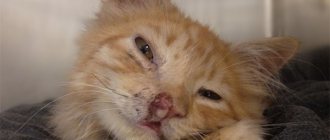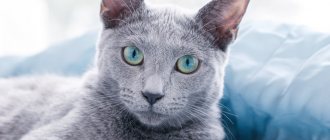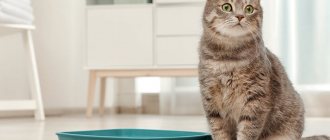Ready-made pellets are the simplest and safest type of diet recommended by most veterinarians. But sometimes cats categorically refuse to eat dry food, discouraging their owners.
In such a situation, you should not immediately give up and switch to natural food, which takes a lot of time and effort to prepare. First, it’s worth understanding the reason for your pet’s strike, since it is not always associated with a dislike of “drying.”
Reasons for refusing dry food
When you notice your mustachioed pet's dissatisfaction, pay attention to specific behavior. Partial refusal to eat, not accompanied by other alarming symptoms, may be temporary.
If the volume in the bowl does not decrease, and the cat experiences severe weakness and apathy, contact your veterinarian. Poor appetite is one of the symptoms of many dangerous diseases. Do not ignore this point, citing the usual pickiness.
Problems with smell
Unlike human receptors, cats are less developed. They perceive taste less well, so when choosing food, cats are repelled by its smell. If you have problems with your sense of smell, even your favorite treats lose their attractiveness.
Poor appetite due to heat, heat, or illness
Another reason for poor appetite is hot weather. At high temperatures, not only humans, but also pets lose interest in food. If your pet lies down most of the time and drinks water heavily, just wait until it gets colder.
The problem can also occur during estrus. The period of sexual heat takes a lot of energy from the pet, so the entire body concentrates on the instinct of reproduction. Other needs are temporarily ignored. Here it is important to observe the absence of other alarming symptoms, since in this case refusal to eat can be interpreted as a sign of pathology.
In case of serious illnesses, there is not just a partial, but a complete refusal to eat. It may be accompanied by fever, gastrointestinal upset and severe weakness. If the sick animal also refuses water, make an appointment at the veterinary clinic as soon as possible. Prolonged dehydration (more than 12-24 hours) can be fatal.
Stress or regime failure
A cat may refuse food due to extreme stress. This often happens when moving, renovating, or adding a new family member.
If your mustachioed pet happily eats handouts and refuses basic food, think about the feeding regime. The lack of a strict schedule and frequent feedings are fraught with overeating and pickiness. By the time of feeding, the cat simply does not have time to get hungry or deliberately ignores the food in the hope of begging for something more tasty.
Rejection of pellets as food
If you have just recently switched your pet to dry feeding after natural feeding, just give him time. The rejection is explained by the less pronounced smell and taste characteristic of ordinary products.
If the cat has been drying for more than a year, check the condition of the teeth. If you have problems with the oral cavity, chewing on hard particles is very painful. In this case, the animal will regularly visit the kitchen and ask for food.
Unsuitable product
This problem often occurs when switching to a higher grade food. Budget brands contain dangerous flavor enhancers and flavorings, while expensive brands contain only natural ingredients.
After poor-quality feeding, the animal needs time to get used to the new diet. In this case, it will be similar to a person trying to switch to a healthy lifestyle after eating fast food for a long time.
Also, the cause of deterioration in appetite may be dissatisfaction with a too monotonous menu. In this case, the diet should be slightly adjusted by adding wet canned food or replacing the existing “crackers” with a different brand.
Damaged product
The taste of ready-made cat food can be ruined not only by the expired expiration date, but also by improper storage. Once the package is opened, the contents quickly oxidize, becoming rancid. Such a product can cause poisoning, so the animal will instinctively refuse it.
Dirty bowl or feeding area
Whiskered pets are very clean. They will not eat from a dirty bowl or eat near their toilet.
In addition to dirt and location, you should consider the material used. Cheap plastic quickly absorbs foreign odors, so the contents of the bowl become unpleasant for the animal. Also, water from a nearby bowl can get into the crackers, turning them into a soggy mess.
First of all - health
Diseases of the teeth and gums are one of the common reasons for refusing dry food while maintaining appetite, so check your pet’s oral cavity. Reddened gums, loose or rotten teeth can be seen with the naked eye, but it is better to consult a veterinarian, especially since you will still have to take the cat to the clinic to prescribe treatment.
If your cat refuses to eat at all, and you observe a drop in activity, weight loss, or other deviations from the norm in the pet’s appearance or behavior, then we are talking about diseases that pose a threat to the animal’s life, so you need to see a doctor as soon as possible. In other cases, you can try to understand the cat’s behavior yourself.
What should the owner do?
The response directly depends on the cause of poor appetite. After finding out, you will have to eliminate the factors that irritate your pet, choose another feeding option, or take time to accustom him to unfamiliar food.
Determining the cause of feed rejection
If you detect alarming symptoms indicating the presence of pathology, you should not put pressure on the animal, forcing it to eat against its desire. In this case, simply contact your veterinarian. After treatment, your appetite will return on its own.
If your cat doesn’t eat dry food well, not because of illness, consider the specific situation:
- Loss of smell. With proper care, a mild cold will quickly go away on its own. If the olfactory function has disappeared due to old age, then it makes sense to switch to natural products with more pronounced odors.
- Hot weather or heat. Both situations resolve on their own after some time. You just need to make sure that your pet drinks the daily amount of water during fasting days.
- Increased anxiety. Create a comfortable corner where the animal can be alone. Give him enough attention to avoid jealousy of the new inhabitants and distract him from other irritating factors.
- Mode failure. Dispense food at specific times, strictly following the recommended portions on the package. Avoid table handouts and remember to include wet canned foods and treats in your daily caloric intake.
- Dental problems. Elderly pets need to choose a more gentle diet that does not injure mucous membranes and loose teeth.
- Recent transition to natural drying or getting used to cheaper brands. Here you need to be patient and just stick to the basic rules. Sooner or later, your pet will come to terms with the new diet and wean itself off the old one.
- Spoiled pellets. Do not buy by weight and do not take large packages that will be stored for more than 1.5 months if opened. After opening the package, pour the contents into an airtight container with a lid and store in a cool, dark place.
- Lack of hygiene or incorrect material. Rinse bowls with boiling water regularly to remove unpleasant odors and kill bacteria. Remember that microcracks in plastic quickly harbor pathogenic microorganisms. It is much safer to purchase products made of metal or ceramics.
When getting accustomed to unusual foods, take into account the timing of fasting. A complete refusal to eat is harmless for 2-3 days in adult animals and for 24 hours in kittens. Don't starve your pet. If your relationship with dry food doesn’t work out, just try other options.
Choosing the right food
The taste of the product plays a significant role. Your pet may not like the taste of chicken or turkey. In this case, choose pellets with lamb, salmon, rabbit, duck or fish. These options will cost more, but they will definitely please your picky eater.
You can also diversify your diet with pieces of meat in spider jelly and soft canned food. Please note that in this case the amount of feed must be reduced.
If all these tricks don’t work, try changing the brand. As a last resort, you will have to switch to natural feeding, since some animals categorically refuse to eat industrial feed.
Accustoming a kitten to pellets
In childhood, the transition to dry food is easier, since the baby has not yet had time to adapt to other products and is familiar only with mother’s milk. “Crusks” can be given as the first complementary food, that is, at 1-1.5 months.
For a healthy diet, lines designed specifically for kittens are suitable. Due to their high calorie content and abundance of vitamins, such products quickly fill you up and promote proper development.
Follow the standards indicated on the packaging and be sure to soak the hard “crackers” in warm water or milk formula until your pet’s first teeth erupt. For the first time, apply the resulting mixture directly to the nose so that the baby will lick it off automatically. Over time, he will get used to the unusual taste and smell.
Having noticed a positive trend, begin to gradually reduce the amount of liquid used. As soon as your pet is confidently chewing dry granules, diversify the diet with wet canned food. Eating foods of varying textures will help prevent gum damage and tartar buildup.
The kitten is naughty
All family members want to pamper the baby, and this desire is quite understandable, but food is not the best, and in any case, not the healthiest way to show your affection. Communication and games are much more important to a kitten, but additional treats can only lead to overeating, although the dry food in the bowl will remain untouched.
Constant chaotic treats also have another danger - the kitten may begin to systematically “extort” tasty treats from each family member in turn, and they, out of the kindness of their hearts, will feed the pet everything that it does not ask for. This situation does not lead to anything good - from digestive disorders to the appearance of excess weight.
Do not follow the kitten’s lead, feed in accordance with the recommended norm, and if the baby is naughty, do not give him anything other than dry food, and warn all family members about this. As a rule, after a few hours of the fast, the appetite returns.
Rules for switching to new food
When changing your usual diet, you need to be patient and consistent. You should not scold an animal or indulge it when it presses for pity. A sharp transition is harmful to health, so the new food needs to be mixed a little with the old one. On average, this takes 1-2 weeks.
Frequent product changes are harmful!
Frequently changing brands is fraught with problems with the gastrointestinal tract. To avoid diarrhea and constipation, veterinarians recommend sticking to a specific brand even on a therapeutic diet. This is not so difficult, since most manufacturers produce several lines that take into account the age and other characteristics of the animal.
Transition from straight
It's not safe to mix different types of foods, so don't be surprised by temporary bowel problems. In this case, this cannot be avoided, so be patient and adhere to the following scheme:
- 25% “drying” and 75% natural – 1-4 days;
- 50% of each type – 5-9 days;
- 75% “drying” and 25% natural – 9-14 days.
At the end of 2 weeks, pellets should make up 100% of the diet. For the first 4 days, you can soak them a little in water so that your pet is not scared off by the unusual consistency.
Switching from wet food
Feeding only wet canned food softens the gums, causing increased bleeding and premature tooth loss. For this reason, they should be combined with dry granules.
The principle of transition here is similar to the previous point. The only difference is that the final proportion must correspond to the instructions on the food packaging. There are detailed rules for feeding animals with 2 types of food.
Please note that increasing the amount of dry kibble will require a large amount of liquid to digest it. Make sure your pet drinks enough water and replace it with fresh water regularly.
How long has it been since you washed your cat's bowl?
It is customary to wash dishes from which people eat after each use, but owners are sometimes reluctant to wash animal bowls. This happens especially often when feeding dry food, because the owners think that it “doesn’t get dirty.” In fact, this is not at all true: when you chew granules, crumbs are formed that settle at the bottom of the bowl, and the fat with which they are soaked remains on its walls.
Depending on the ambient temperature, it takes from several hours to several days for fats to completely deteriorate in light and air, so wash your cat’s bowl daily with warm water and detergent. In summer, it is advisable to perform this procedure even more often. Otherwise, your cat's keen sense of smell will signal to her that the food is spoiled, even if you just poured fresh granules.
Whiskers sensitivity
A cat's whiskers are sensory receptors connected to their nervous system. Any movements or touches send signals to the brain.
Some cats don't like their whiskers getting dirty and clinging to the bowl.
When the whiskers touch the food and bowl too often, it results in an overload of sensory messages. The cat may become nervous and lose its appetite. This phenomenon is called “whisker fatigue.”
Here are the symptoms that your cat is experiencing “whisker fatigue”:
- walks around the bowl and meows
- refuses to eat from his own bowl
- trying to get food out of the bowl
- becomes aggressive with food when he takes it out of the bowl
Solution: a wide but shallow bowl that is comfortable for the cat.
Physiological causes of decreased appetite in cats
Cats are characterized by instability of appetite, this is due to the fact that they are predators. In their natural habitat, cats do not have the opportunity to receive food in the same amount every day. Today she was lucky to catch three mice and one bird, and tomorrow only one mouse. For our pets, food is always available in the right quantity, but sometimes they can relieve their body for a day and eat a little less food than usual without harm to their health.
Another factor influencing appetite is the sexual activity of animals. Uncastrated representatives of the cat tribe, in search of love, sometimes completely forget about food, and doctors will not help here. If a pet is losing weight, and the owner does not consider it necessary to castrate it, then he must take care of the calorie content of the diet so that the animal receives the required amount of energy in small portions.
To understand that a cat has become poor at eating food precisely for a physiological reason, you need to carefully observe it throughout the day. If she continues to drink water, is active, sociable, has a clear look, and her natural functions remain normal, then there is no need to worry. If fasting continues for more than a day while feeling well, or you notice your cat is feeling unwell already on the first day, you should immediately show her to a veterinarian - the sooner treatment begins, the easier and more effective it will be.
